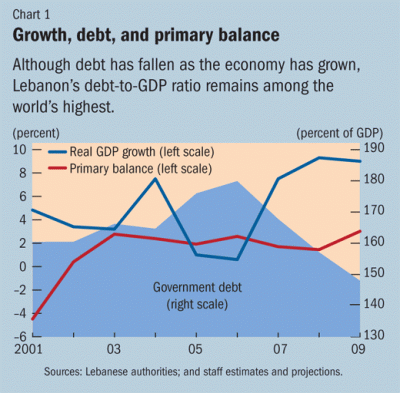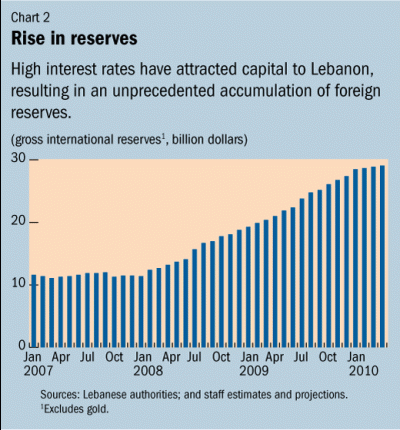
Lebanon’s economy is booming. But to sustain the current growth spell and translate economic expansion into jobs and broader social gains, the country must strengthen public finances, upgrade its infrastructure, and improve the business environment, say IMF economists.
In its annual health check of the Lebanese economy, the IMF found that domestic economic and financial conditions remain favorable, possibly more so than at any point since the civil war ended in 1990. After two years of relative political stability, the country has shown an exceptional resilience in the face of the global financial crisis and a capacity to rebound and thrive. Led by a dynamic private sector, Lebanon grew an estimated 9 percent in 2009 and is projected to grow by 8 percent in 2010, according to the IMF assessment.
Every year, the IMF conducts reviews of its member countries’ economies. The analysis is subsequently discussed by the IMF’s 24-member Executive Board.
Sustaining the growth momentum
To sustain the current rebound in growth and to achieve durable job creation, a major effort is needed to upgrade the country’s infrastructure (mainly electricity and water supply, telecommunications, and transport) and improve the business environment. Growth is currently concentrated in a few sectors—retail trade, tourism services, and construction—in and around Beirut, the capital. To achieve more widespread and durable growth, electricity and water must be provided around the clock; energy, telecommunication, and transportation costs reduced; and internet services improved.
But the government will need to reconcile plans for a substantial increase in infrastructure investments with the need to maintain macroeconomic stability and reduce the country’s debt burden. While significantly reduced in recent years, Lebanon’s public debt—at about 148 percent of GDP—still ranks among the highest in the world and drains about half of the annual budget revenues in interest payments, leaving little room for productive public spending (see Chart 1). The need to periodically refinance this large stock of debt is a source of vulnerability, despite the country’s dedicated and resilient investor base.

A determined strategy to reduce the debt-to-GDP ratio is thus essential, the IMF said. Such a strategy should not rely solely on economic growth but also focus on creating fiscal space to reduce the deficit while increasing social spending and public investment in infrastructure. This will require increasing tax revenues—in an efficient and equitable manner, by broadening the tax base and possibly raising some tax rates—and cutting inefficient public spending, including through electricity sector reforms to reduce the need for large untargeted transfers from the budget.
Maintaining macroeconomic stability
In the near term, a key issue is to manage the buoyant economy to avoid excessive pressures on consumer and real estate prices and a widening of the external current account deficit, among other things. This will require a prudent fiscal policy stance as well as monetary and prudential policies aimed at tempering deposit inflows and avoiding excessive credit growth. At the same time, risks of a slowdown in growth—for example, from the recent rise in political tensions—must also be monitored.
In the medium term, the main challenges are to address the sizeable remaining macro-financial vulnerabilities and implement growth-enhancing structural reforms. This involves taking decisive measures to gradually reduce the budget deficit (which reached over 8 percent of GDP last year), and relaunching the structural reform agenda to maintain high and sustainable rates of growth.
Keeping the financial sector sound
The Central Bank has been successful in shielding Lebanon from the global financial turmoil. Attractive interest rates promoted continued deposit inflows, thereby supporting the exchange rate peg and allowing an unprecedented accumulation of foreign exchange reserves during the past two years (see Chart 2). Now that central bank reserves have reached a comfortable level, policy interest rates have been appropriately lowered to moderate deposit inflows to a pace that can be more readily absorbed by the economy.

With Lebanon’s banking sector thriving, the authorities should continue to strengthen bank regulation and supervision and to prevent excessive risk taking. Prudent regulation helped prevent Lebanese banks from being overly exposed to risky assets, a strategy that proved far-sighted during the global financial crisis, the analysis said.
Now, with a thriving economy and real estate sector, care should be taken to prevent any weakening in credit standards and excessive leverage. Domestic banks are expanding abroad to diversify their business and take advantage of growth opportunities in other markets. This is a welcome development, but also requires a sharp focus on cross-border supervision to ensure that the banking sector remains strong.

Leave a Reply
You must be logged in to post a comment.